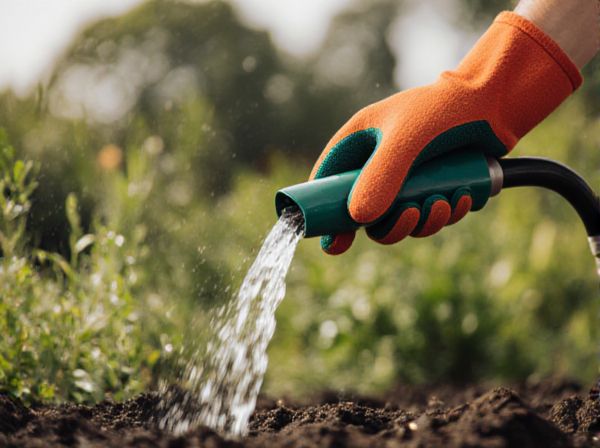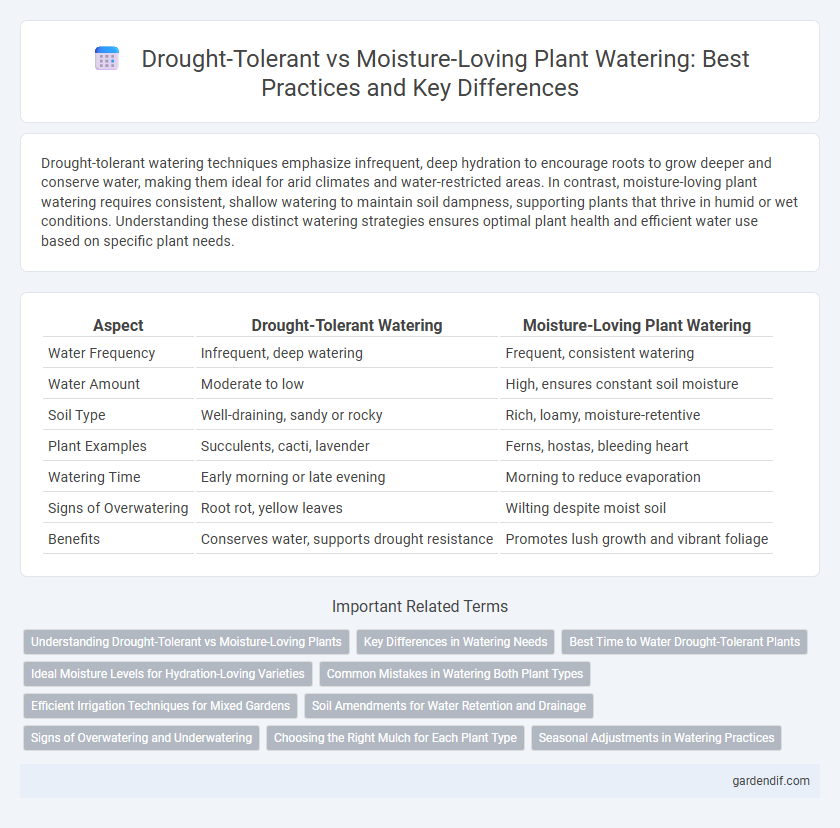
Drought-tolerant watering vs Moisture-loving plant watering Illustration
Drought-tolerant watering techniques emphasize infrequent, deep hydration to encourage roots to grow deeper and conserve water, making them ideal for arid climates and water-restricted areas. In contrast, moisture-loving plant watering requires consistent, shallow watering to maintain soil dampness, supporting plants that thrive in humid or wet conditions. Understanding these distinct watering strategies ensures optimal plant health and efficient water use based on specific plant needs.
Table of Comparison
| Aspect | Drought-Tolerant Watering | Moisture-Loving Plant Watering |
|---|---|---|
| Water Frequency | Infrequent, deep watering | Frequent, consistent watering |
| Water Amount | Moderate to low | High, ensures constant soil moisture |
| Soil Type | Well-draining, sandy or rocky | Rich, loamy, moisture-retentive |
| Plant Examples | Succulents, cacti, lavender | Ferns, hostas, bleeding heart |
| Watering Time | Early morning or late evening | Morning to reduce evaporation |
| Signs of Overwatering | Root rot, yellow leaves | Wilting despite moist soil |
| Benefits | Conserves water, supports drought resistance | Promotes lush growth and vibrant foliage |
Understanding Drought-Tolerant vs Moisture-Loving Plants
Drought-tolerant plants require infrequent, deep watering to encourage root growth and conserve water, thriving in dry, arid conditions with minimal moisture. Moisture-loving plants demand consistent, frequent watering to maintain their hydration and prevent stress, often found in humid or water-abundant environments. Understanding the distinct watering needs of these plant types enhances garden health and optimizes water use efficiency.
Key Differences in Watering Needs
Drought-tolerant plants require infrequent, deep watering to encourage root growth and conserve water, thriving in well-drained soil with low moisture levels. Moisture-loving plants demand consistent, frequent watering to maintain damp soil conditions, often benefiting from mulch to retain soil moisture and prevent drying out. Understanding these distinct watering needs helps optimize plant health and water usage efficiency in various garden conditions.
Best Time to Water Drought-Tolerant Plants
Watering drought-tolerant plants is most effective during early morning or late evening when evaporation rates are low, ensuring water soaks deeply into the root zone. These plants require less frequent watering compared to moisture-loving plants, which benefit from consistent moisture throughout the day. Optimal watering times reduce water waste and support the natural resilience of xerophytic species.
Ideal Moisture Levels for Hydration-Loving Varieties
Moisture-loving plants thrive in consistently damp soil, requiring ideal moisture levels between 60-80% field capacity to prevent stress and promote optimal growth. Overwatering can lead to root rot, so maintaining a balance with frequent, moderate watering is essential for hydration-loving varieties. These plants benefit from mulching and regular monitoring of soil moisture to ensure hydration without waterlogging.
Common Mistakes in Watering Both Plant Types
Overwatering drought-tolerant plants often leads to root rot, as these species require well-drained soil and infrequent watering to thrive. In contrast, moisture-loving plants suffer from underwatering, which causes leaf wilting and stunted growth due to their need for consistently damp soil. Ignoring the specific water needs of each plant type disrupts their health, emphasizing the importance of tailored irrigation strategies.
Efficient Irrigation Techniques for Mixed Gardens
Drought-tolerant plants benefit from deep, infrequent watering methods such as drip irrigation that deliver water directly to the root zone, reducing evaporation and runoff. Moisture-loving plants require more frequent, shallow watering to maintain consistent soil moisture, which can be achieved using soaker hoses or micro-sprinklers. Combining these techniques in mixed gardens optimizes water use efficiency by tailoring irrigation schedules to plant water needs, promoting healthy growth while conserving water resources.
Soil Amendments for Water Retention and Drainage
Soil amendments play a crucial role in optimizing watering strategies for both drought-tolerant and moisture-loving plants by enhancing water retention and drainage. For drought-tolerant plants, incorporating organic matter like compost and vermiculite improves soil structure, promoting moisture retention while preventing waterlogging. In contrast, moisture-loving plants benefit from amendments such as coarse sand or perlite that increase soil aeration and drainage, reducing the risk of root rot in consistently moist conditions.
Signs of Overwatering and Underwatering
Drought-tolerant plants often show signs of underwatering through leaf curling, wilting, and dry, brittle foliage, while overwatering manifests as yellowing leaves and root rot. Moisture-loving plants exhibit underwatering symptoms such as drooping leaves and slowed growth, whereas overwatering causes leaf yellowing, soft stems, and fungal infections. Proper watering schedules tailored to plant type prevent stress, optimize growth, and maintain plant health in diverse environmental conditions.
Choosing the Right Mulch for Each Plant Type
Selecting the right mulch for drought-tolerant plants involves using materials like gravel, bark chips, or coarse sand that enhance soil drainage and reduce moisture retention, preventing root rot. Moisture-loving plants benefit from organic mulches such as compost, straw, or shredded leaves that help retain consistent soil moisture and improve nutrient content. Tailoring mulch choice to each plant's water needs optimizes garden health and conserves water efficiently.
Seasonal Adjustments in Watering Practices
Drought-tolerant plants require significantly less frequent watering, relying on deep, infrequent soakings to promote root resilience, especially during dry seasons. Moisture-loving plants demand consistent, shallow watering to maintain surface soil moisture and prevent stress, with increased frequency during hotter months. Seasonal adjustments include reducing irrigation for drought-tolerant species in cooler months and increasing watering for moisture-loving plants during peak growth periods to optimize health and conserve water.
Drought-tolerant watering vs Moisture-loving plant watering Infographic

 gardendif.com
gardendif.com